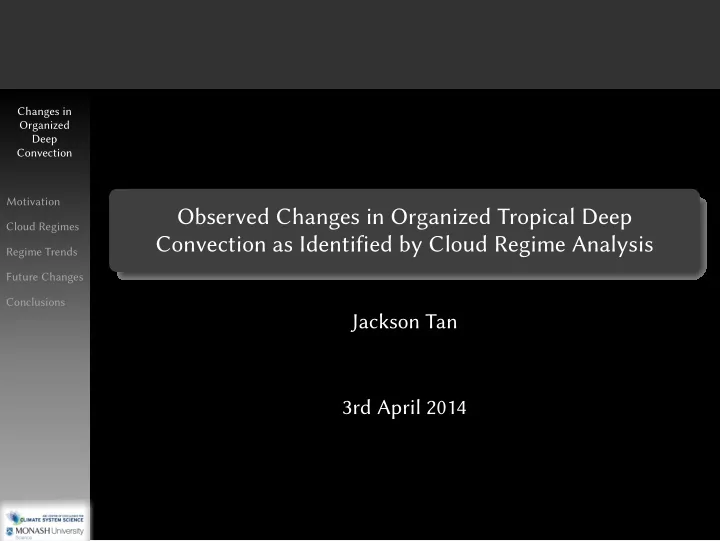

Changes in Organized Deep Convection Motivation Observed Changes in Organized Tropical Deep Cloud Regimes Convection as Identified by Cloud Regime Analysis Regime Trends Future Changes Conclusions Jackson Tan 3rd April 2014
Motivation: Changes in Org. Deep Conv. Changes in Organized Deep Convection Motivation Motivation Organized deep convection has a critical impact on the climate Cloud Regimes system, but we know little about how it has changed globally in Regime Trends the past and will change in a warming climate. Future Changes Conclusions GCMs cannot properly represent organized deep convection lack of observations that are both global and sufficiently long
Org. Deep Conv. Has Increased by 20% Changes in Organized Deep Convection Motivation Cloud Regimes Regime Trends Future Changes Conclusions (Tselioudis et al., 2010)
Changes in Organized Deep Convection Motivation Cloud Regimes Regime Trends How do they represent organized deep convection? Future Changes Conclusions
Representing Org. Deep Conv. with Cloud Regime Changes in Organized Deep Convection Motivation by cloud regimes (or weather states) Cloud Regimes Regime Trends classification of the convective state of the atmosphere Future Changes Conclusions one regime in particular characterizes an environment of organised deep convection
Aims: Changes in this Regime and Other Regimes Changes in Organized Deep Convection Aims Motivation Cloud Regimes Regime Trends 1. how has this organized deep convective regime changed Future Changes internally ? Conclusions 2. how have other regimes of less organized deep convection changed?
Cloud Regimes as Convective Indicators Changes in Organized Deep Convection first proposed by Jakob and Tselioudis (2003) Motivation Cloud Regimes Regime Trends classification of cloud fields by k -means clustering of Future Changes joint-histograms of CTP and τ Conclusions 280 km × 280 km, daily time resolution, 35 ◦ N/S indicators of the convective state of the atmosphere
CTP (hPa) 0.0 680 440 310 180 10 CR2 8.4% CR3 14.2% 0.2 1000 1.0 2.0 3.0 4.0 6.0 8.0 10.0 15.0 20.0 (%) 800 560 CR1 310 5.5% 440 560 680 180 800 1000 10 Three Regimes Describe Deep Convection Changes in Organized Deep Convection Motivation Cloud Regimes Regime Trends Future Changes Conclusions 3 0 3 0 2 6 4 3 0 2 6 4 3 0 . 0 . 0 0 . . 2 6 0 . . 2 6 1 3 9 1 3 9 . 0 . 0 0 0 1 1 τ
CTP (hPa) 0.0 560 440 310 180 10 CR2 8.4% CR3 14.2% 0.2 1000 1.0 2.0 3.0 4.0 6.0 8.0 10.0 15.0 20.0 (%) 800 680 CR1a 800 1.4% CR1b 4.1% 180 310 440 560 10 680 1000 Re-clustering CR1 Gives Two Sub-Regimes Changes in Organized Deep Convection Motivation Cloud Regimes Regime Trends Future Changes Conclusions 3 0 3 0 2 6 4 3 0 2 6 4 3 0 . 0 . 0 0 . . 2 6 0 . . 2 6 1 3 9 1 3 9 . 0 . 0 0 0 1 1 τ
Caution in Using ISCCP in Trend Studies! Changes in Organized Deep Convection Motivation Cloud Regimes Regime Trends Future Changes Conclusions
METEOSAT GOES-EAST GOES-WEST GMS INSAT METEOSAT Minimize Artifacts by Zenith Angle Filter Changes in Organized Deep Convection one main source of satellite artifacts due to high satellite zenith angles µ Motivation Cloud Regimes generally a ff ects the threshold detection of optically thin Regime Trends clouds Future Changes Conclusions set zenith angle filter µ > 30 ◦ to minimize such artifacts
Changes in Organized Deep Convection Motivation Cloud Regimes Regime Trends How does our approach compare with Tselioudis et al. (2010)? Future Changes Conclusions
( 15.8 ± 5.7)% 2000 CR1 0.09 0.08 0.07 0.06 0.05 0.04 0.03 0.02 2010 2005 1995 1990 1985 1980 Result Consistent with Tselioudis et al. (2010) Changes in Organized Deep Convection Motivation Cloud Regimes Regime Trends Future Changes Conclusions
Changes in Organized Deep Convection Motivation Cloud Regimes Regime Trends How has CR1a changed? Future Changes Conclusions
( 82.8 ± 24.1)% 1985 ( 96.9 ± 15.0)% 0.00 0.02 0.04 GOES-WEST ( 60.8 ± 30.3)% 1980 1990 0.10 1995 2000 2005 2010 0.00 0.02 0.04 GOES-EAST GMS 0.05 0.02 (110.4 ± 62.6)% INSAT 0.04 0.02 0.00 ( 55.4 ± 30.5)% METEOSAT 0.04 0.00 0.00 CR1a Increasing in Every Satellite Region Changes in Organized Deep Convection Motivation Cloud Regimes Regime Trends Future Changes Conclusions
Changes in Organized Deep Convection Motivation Cloud Regimes Regime Trends How has other regimes changed? Future Changes Conclusions
( 4.9 ± 4.5)% 1985 CR2 (-13.9 ± 7.1)% 0.1 0.2 CR3 ( 11.9 ± 5.8)% 1980 1990 0.0 1995 2000 2005 2010 0.2 0.4 Conv. 0.1 ( 3.2 ± 6.6)% 0.00 0.10 0.05 0.00 ( 56.7 ± 9.8)% CR1a 0.04 0.02 CR1b CR1a Increases But Convective Regimes Constant Changes in Organized Deep Convection Motivation Cloud Regimes Regime Trends Future Changes Conclusions
( 4.9 ± 4.5)% 1985 CR2 (-13.9 ± 7.1)% 0.1 0.2 CR3 ( 11.9 ± 5.8)% 1980 1990 0.0 1995 2000 2005 2010 0.2 0.4 Conv. 0.1 ( 3.2 ± 6.6)% 0.00 0.10 0.05 0.00 ( 33.2 ± 11.1)% CR1a 0.04 0.02 CR1b Still an Increase when Jumps are Removed Changes in Organized Deep Convection Motivation Cloud Regimes Regime Trends Future Changes Conclusions
Changes in Organized Deep Convection Motivation Cloud Regimes Regime Trends How will organised deep convection change in the future? Future Changes Conclusions
CR1a (corr = 0.475) 14.6 CR1 (corr = 0.240) FOC 0.10 0.08 0.06 0.04 0.02 0.00 global mean surface temperature (°C) 15.0 14.8 14.4 14.2 14.0 13.8 CR1a/CR1 May Increase in a Warming Climate Changes in Organized Deep Convection Motivation Cloud Regimes Regime Trends Future Changes Conclusions
Conclusions Changes in Organized Deep Conclusions Convection 1. increase in organized deep convection is due increase in Motivation the more intense component Cloud Regimes 2. area of deep convection remained constant but has Regime Trends intensified into more organized modes Future Changes Conclusions 3. a warmer climate may have more organised deep convection To Do Address other sources of satellite artifacts, such as from polar-orbiting satellites
Recommend
More recommend